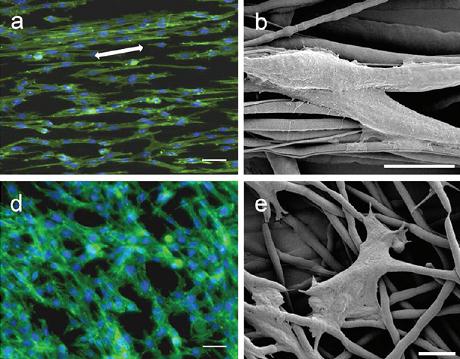


Copyright@2011 University of South Carolina

Cell Culture with Plant Viruses
We discovered that cell adhesion, spreading, migration, and differentiation can be modulated by the functionalities displayed on BNPs and their assembly patterns. The surface properties of VPs can be used to modulate the cell attachment and proliferation.

Cell-matrix interactions
Langmuir, 2012, 28, 2028-2034
Life processes between cells and their fluidic and surface environments are complex. Many studies have demonstrated that density and defined spatial organization (orientation, distance and geometry) of multivalent ligands on cell surfaces and extracellular matrix account for the complexity of cellular signaling. The challenge in probing and utilizing these mechanistic controls of cellular functions requires a programmable two-dimensional (2D) or three-dimensional (3D) environment, which are structured with micro- and nanoscale features resembling some selected aspects of natural systems such as ligand distance, density and spatial arrangement.
Electrospun fibrous scaffolds with random and aligned fiber orientations were created in order to mimic the three-dimensional structure of the natural extracellular matrix (ECM). The breast cancer cells showed elongated spindle-like morphology in the aligned fibers. Gene expression profiling of these cells post seeding showed up-regulation of transforming growth factor ¦Â-1 (TGF¦Â-1) along with other mesenchymal biomarkers, suggesting that these cells undergo epithelial-mesenchymal transitions (EMT) in response to the polymer scaffold. The results implies that the biophysical attributes of a tumor microenvironment like ECM alignment may be sufficient to induce the occurrence of EMT in cancer cells.

Chem. Commun., 2008, 5185-5187
Acta Biomater., 2008, 4, 838-843
Biomaterials, 2008, 29, 4074-4081
Biomaterials, 2010, 31, 1732-1741
Biomaterials, 2010, 31, 5813-5824
Langmuir, 2011, 27, 9490-9496
Biomacromolecules, 2012, 13, 422-431
Acta Biomater., 2008, 4, 838-843
Biomaterials, 2008, 29, 4074-4081
Biomaterials, 2010, 31, 1732-1741
Biomaterials, 2010, 31, 5813-5824
Langmuir, 2011, 27, 9490-9496
Biomacromolecules, 2012, 13, 422-431
Moreover, we found that the differentiation of bone mesenchymal stem cells into osteoblasts can be greatly enhanced using plant viruses as substrates.
•
Cell Study With Electrospun fibrous scaffolds
•



